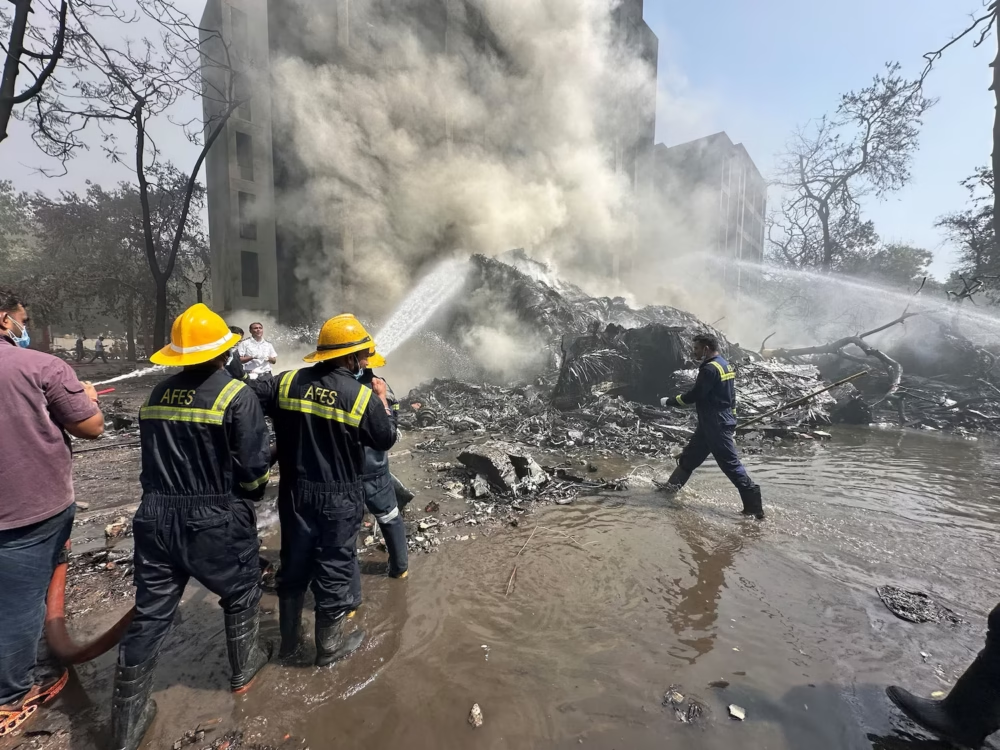Analysis
Why Air India’s Tragedy Could Reshape the Tata Group’s Aviation Ambitions
How the fatal crash of Flight AI171 threatens Tata’s bold aviation revival—raising urgent questions about safety, oversight, and the future of Air India.
The Takeoff That Never Found the Sky
Ahmedabad, June 12, 2025 — It was supposed to be just another journey in a rapidly modernizing Indian skies. At 1:39 PM IST, Air India Flight AI171—a Boeing 787-8 Dreamliner with the tail number VT-ANB—gathered speed on Runway 23, bound for London Gatwick.
On board were 230 passengers and 12 crew members. Families returning home, business travelers, and students filled the cabin—Indian, British, Portuguese, and Canadian nationals alike.
But just 30 seconds into flight, before the aircraft could truly lift into the blue, it began a silent, deadly descent. From a brief peak of around 625 feet, the Dreamliner dropped at a rate of 475 feet per minute. Seconds later, it disappeared from radar and slammed into a medical hostel near B.J. Medical College—just two kilometers from the airport.
In an instant, the tragedy claimed 241 lives in the sky and at least 28 on the ground. Among the lost: former Gujarat Chief Minister Vijay Rupani, who had boarded with minimal security in an understated departure.
Only one survivor was pulled from the wreckage: 28-year-old Vishwash Kumar Ramesh, seated in 11A. Rescued hours later by emergency teams, his survival has come to symbolize not just fate’s cruelty, but its unpredictable mercy.
As smoke curled into the sky above Ahmedabad, questions fell even faster than the wreckage. Was it pilot error? A technical fault? Did the aircraft ever have a fighting chance?

Rescue team members work as smoke rises at the site where an Air India plane crashed in Ahmedabad, India, June 12, 2025. Amit Dave:Reuters
A Dreamliner Disaster, A Strategic Earthquake
This wasn’t just a plane crash. It was a direct blow to one of India’s most ambitious corporate projects: the Tata Group’s aviation renaissance.
After reclaiming Air India from government ownership in 2022, Tata Sons launched a sweeping vision. With billions in aircraft orders, premium branding, and a commitment to unite India’s fragmented air travel landscape, the goal was clear: make Air India a global powerhouse.
But this tragedy threatens to ground more than a plane. It shakes the very idea that India’s aviation sector is ready for international prestige.
Dreams of a New Sky Meet the Weight of Reality
A Perfect Storm of Aspirations and Assumptions
In recent months, Air India had been rolling out new long-haul routes and touting its transformation. Sleek new ads, revamped lounges, and redesigned uniforms hinted at a renaissance. But the crash casts a long shadow.
Public perception—of safety, of competence, of Tata’s readiness—is now in question.
A Fleet in the Spotlight
Tata’s bet was heavily placed on a modern, tech-savvy fleet. Hundreds of Boeing and Airbus jets had been ordered, forming the backbone of its global ambitions.
Now, those decisions are under review. Boeing—still under scrutiny worldwide for previous manufacturing lapses—will have its reliability reevaluated in the Indian context. What was once seen as a smart fleet refresh is now tangled with questions of safety checks, procurement transparency, and regulatory oversight.
Leadership at a Crossroads
CEO Campbell Wilson and Tata Chairman N. Chandrasekaran now face the most sobering challenge of their aviation stewardship.
Did growth outpace governance? Were safety protocols and crew preparedness given the same urgency as business expansion?
More broadly, how does a brand built on trust respond when that very trust is shaken?
The Warnings Were There—But Were They Heard?
For months—if not years—aviation insiders had flagged concerns.
Engineers and whistleblowers warned of deferred maintenance, overstretched training programs, and a DGCA (Directorate General of Civil Aviation) struggling to balance oversight with a booming air travel market.
In the race to make Air India “world-class,” critics say the fundamentals may have been compromised. The very culture of accountability may have taken a backseat to optics.
Repercussions Beyond the Runway
The immediate fallout is devastating. Insurance liabilities could top billions. Dozens of nations are demanding answers.
But the deeper cost may lie in trust—from investors, from passengers, from global partners.
This was supposed to be India’s aviation moment. The country is the world’s fastest-growing air travel market, and Air India, under Tata, was meant to lead that charge.
Now, every aspect of that vision must be reexamined. Not abandoned—but rebuilt, with greater humility and deeper rigor.
A Moment of Reckoning—and Redefinition
What does it mean to build a world-class airline in today’s India?
It’s more than wide-body jets and Michelin-star menus in business class. It’s about safety, culture, transparency, and people. It’s about remembering that every seat sold is a life entrusted.
The crash of AI171 will become a case study—not just in aviation safety, but in corporate responsibility. It will be discussed in boardrooms, classrooms, and living rooms alike.
Can the Vision Still Fly?
The tragedy of Flight AI171 has done more than shake Air India’s reputation—it has tested the very soul of the Tata Group’s aviation ambitions.
The black boxes may eventually tell us what happened that day. But the more important answers will come in the months that follow: how Tata responds, how systems reform, and whether India’s flag carrier can rise again—not just in the skies, but in the hearts of its people.
The runway to global greatness is still there. The question is: can it be safely reached?
Final Thoughts
Crashes define more than a moment. They reveal what was broken long before impact—and what must be rebuilt after. The Tata Group, and India’s aviation story, now stand at a pivotal junction. One where leadership, trust, and action will speak louder than ambition ever could.